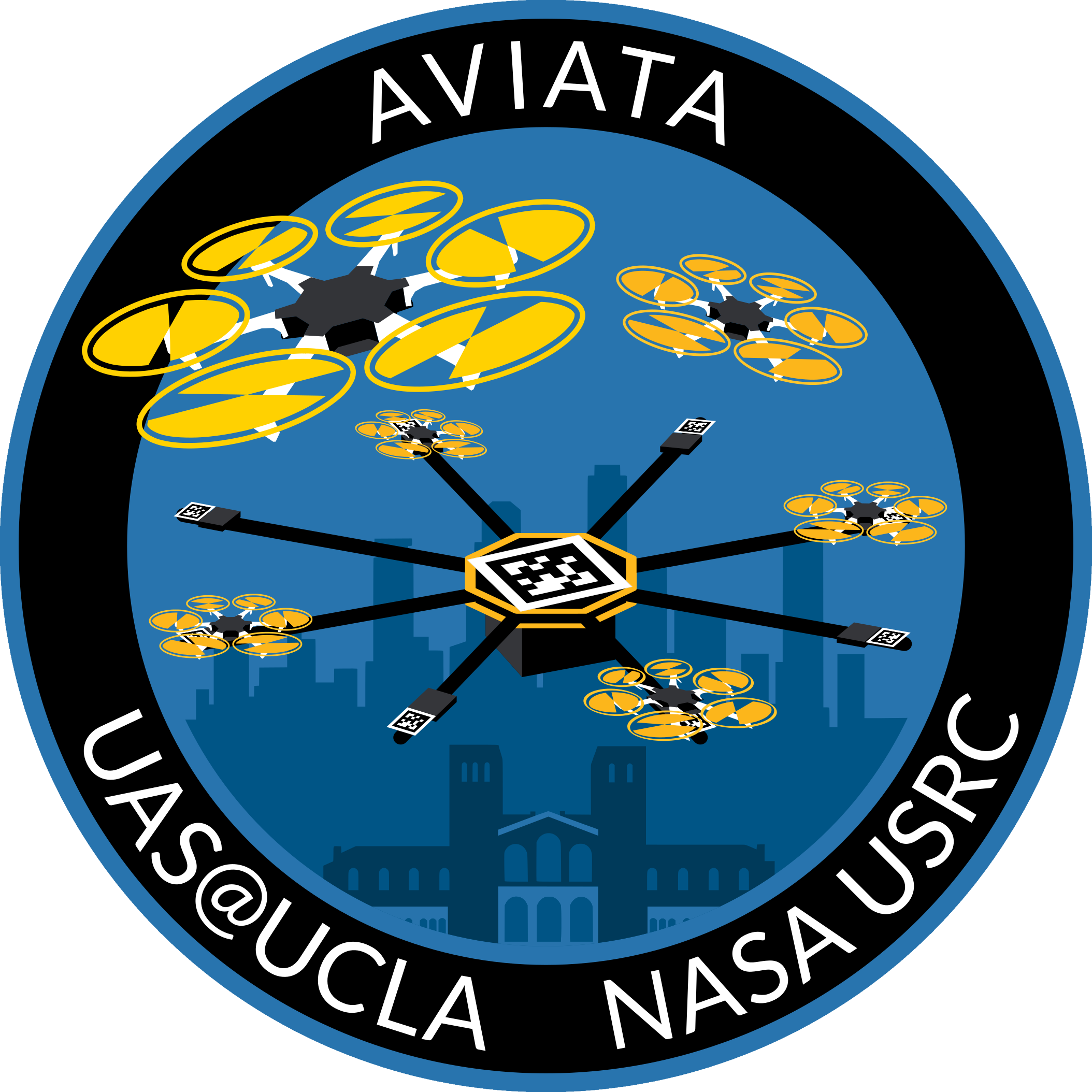
Update #1: September 18, 2020
When the COVID-19 pandemic hit the US and stay-at-home orders began, we at UAS@UCLA learned
that we wouldn't get the chance to fly our brand-new UAV at the annual AUVSI-SUAS competition in Maryland this
year. This left us with a lot of time on our hands and not much to show for our work this school
year.
Fortunately, we were informed of a little-known NASA research grant for undergraduate students, called
the University Student Research Challenge (USRC). The onus is on the students to come up with a research topic
that aligns with NASA's mission, and to then draft a research proposal for it. Our topic? AVIATA - the
Autonomous Vehicle Infinite Flight Time Apparatus. We plan to build a swarm of drones that's able to collaborate
together to carry heavy items for an infinite amount of time by innovatively swapping charged and discharged
drones in and out of the swarm.
Fast-forward to July 2020. NASA reached out to us and let us know we had been
selected to receive grant money to fund our project! Riding on the heels of this fantastic news, we launched a
successful crowdfunding campaign as required by the USRC, which unlocked access to more of NASA's pledged grant
money, and today we are in the initial stages of project design and planning.
Software Design
Author: Axel Malahieude
Firstly, it was important to determine what the software team would be responsible for.
While we have a hardware team designing the mechanical aspects of AVIATA, the software team would be in charge
of creating the control systems. This means figuring out how to make several drones fly together, how to
communicate with the drone swarm, and how to autonomously dock and undock from the structure while in
flight.
In the design stage, we are having high-level discussions on how these processes will work.
Currently, this involves a lot of flow-charting and “what if” conversations to make sure we handle all possible
scenarios. For example, what if a drone flies to the structure to replace another drone, but it's unable to find
it's docking location?
Another software-oriented goal is to develop simulation capabilities. One of our
engineers, Ryan, has successfully created a Python program that can model how the drone swarm would react if a
drone were to leave. This is important because it will allow us to predict the minimum number and configuration
of drones we need based on the current weight we're carrying. So far, the results are very promising, and we'll
continue to develop this simulator.
The goal for the upcoming weeks is to fully flesh out what AVIATA will
look like from a software perspective. We have a preliminary design review planned for mid-October, where we
hope to get constructive feedback on our current design. Afterwards, we'll be ready to start writing code and
programming the drones.
Hardware Design
Author: Bhrugu Mallajosyula
As you might imagine, developing a collaborative drone swarm for lifting objects involves a
whole host of technical challenges, both mechanical and in software, that need to be dealt with to produce a
robust final product. The hardware team's job is to design the fixtures and mechanisms that help this type of
interdrone collaboration run smoothly, and to make the software team's job easier by reducing the mechanical
uncertainties that make communication and control more difficult.
The hardware team focuses on three main
areas of development: a frame to which the payload is secured, the docking mechanism that facilitates the
drones' attachment to and detachment from the frame, and modifications to existing drones so that they function
as desired within our system. Though Covid-19 related restrictions make it difficult for team members to meet in
person, we've developed a plan for distributing manpower and resources between each of these areas so that we
can make steady progress even without in person meetings for the foreseeable future.
The hardware team is
already hard at work researching, prototyping, and designing the components to make our system run smoothly. For
development of the frame, one of our engineers, Willy, has determined the weight budget for the frame and
payload by calculating the thrust produced by only three drones flying in suboptimal conditions. Another
engineer, James, is researching ways to reduce oscillation and vibration of the payload, by damping or other
means, to reduce the corrections that need to be made during flight in software.
For the docking mechanism,
I've been testing a series of 3D printed fixtures that attach to either the frame or a swarm drone to help
magnetically align the drones in the proper orientation for attachment. Progress on all fronts has been smooth
and continual so far.
Over the next few weeks the hardware team plans to finalize our preliminary design and
test subassemblies individually before moving to the next stage of development. We hope to test the docking
mechanism using a human-piloted hexacopter before our preliminary design review in mid-October, where UCLA
faculty and industry experts will give us feedback on our developments up until that point. We're very excited
about this project and our progress, and hope you'll stick around with us on this journey.
Acknowledgment
These results are based upon work supported by the NASA Aeronautics Research Mission
Directorate under award number 80NSSC20K1452. This material is based upon a proposal tentatively selected by
NASA for a grant award of $10,811, subject to successful crowdfunding. Any opinions, findings, and conclusions
or recommendations expressed in this material are those of the authors and do not necessarily reflect the views
of NASA.
 Join
Calendar
Officers
Gallery
Tools
Join
Calendar
Officers
Gallery
Tools
